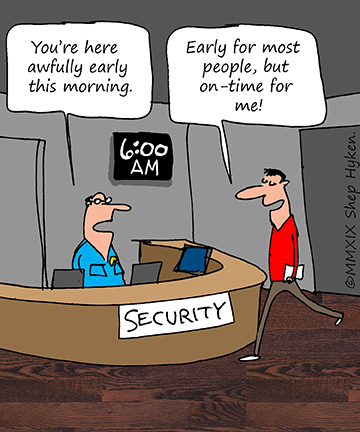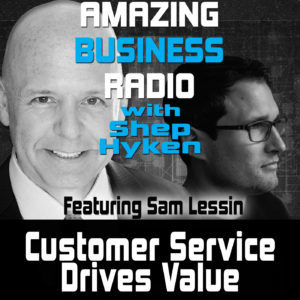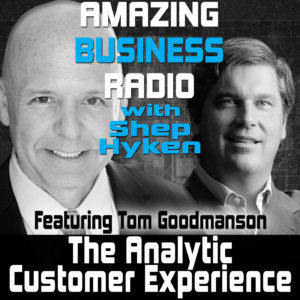Shep Hyken's Blog, page 118
October 14, 2019
5 Top Customer Service Articles for the Week of October 14, 2019
Each week I read a number of customer service and customer experience articles from various resources. Here are my top five picks from last week. I have added my comment about each article and would like to hear what you think too.
6 Customer Service Tenets Used By Amazon To Create Effortless Experiences by Dan Gingiss
(Forbes) Amazon’s six “Customer Service Tenets” – posted throughout its offices — explain a lot about why Amazon is so easy and pleasurable to do business with, and can be used as inspiration for any company looking to improve its customer service.
My Comment: Whenever there is an article about Amazon, teaching how they do what they do, I take the time to read it. Dan Gingiss shares the Six Customer Service Tenets that Amazon posts in its offices and shares some commentary about each one. Its nothing you wouldn’t expect from a company recognized for being truly customer-focused. As a matter of fact, it’s something you should expect from every company you do business with.
4 Ways to Celebrate Customer Service Week by Whitney Puidokas
(Lose It!) Here are the four ways we celebrated the hard work our Customer Care team puts in every day. We hope one of these ideas can make their way into how you think about honoring your customer-facing employees!
My Comment: Last week was Customer Service Week. While many people think the “holiday” (That’s how I refer to it.) is focused on the customer, it was originally created to recognize all the people in a business who take care of customers. That said, this short article has four great ideas you can use year-round! Even though the celebration lasts for the week, the concepts should be practiced all 52 weeks throughout the year.
A Foundation in Customer Experience Should Start in College by Janelle Estes and Lija Hogan
(CMSWire) Every business school touts its ability to develop the next generation of business leaders by providing a foundation in finance, economics, operations, marketing, management and strategy. But most could be doing a better job training students in what has become one of the most important areas of business today: digital customer experience.
My Comment: It’s never to early to start teaching our kids about customer service and experience. As a matter of fact, the authors of this article believe the foundation of customer experience should start in college. As we move into an era where customer experience is becoming one of the most important strategies in business, a foundation and understanding should start in school. The students that understand the importance of customer service and experience as they enter the workforce will have a great advantage over those that don’t.
Crash and Churn: survey reveals the customer service fails that cause attrition by Andrew Mort
(CustomerThink) The days of long-term customer brand loyalty to brands are over. Today, consumer stickiness is far more dependent upon people’s specific experiences and the level of service they receive. Some turnover must always be expected – that’s the nature of competition, after all – but a high churn rate due to substandard customer service is unacceptable, and often entirely avoidable.
My Comment: What causes your customers to leave and not come back? A big part of it may be the high effort you cause customers when they want to do business with you. Here’s a short article with a link to an excellent report. Be sure to download the report.
Customer Experience Around The World: 25 Examples Of Best Practices You Haven’t Heard Of by Blake Morgan
(Forbes) These 25 global experiences showcase customer-centric companies from around the world.
My Comment: My friend Blake Morgan has written an interesting article on customer experience that showcases 25 best practices we haven’t heard of. This is a great opportunity to read a number of ideas from some customer experience rock star companies. Bring some of these ideas to your next strategy meeting and plan to have a fascinating and important conversation.
 Shep Hyken is a customer service expert, professional speaker and New York Times bestselling business author. For information on The Customer Focus
Shep Hyken is a customer service expert, professional speaker and New York Times bestselling business author. For information on The Customer Focus customer service training programs go to www.TheCustomerFocus.com. Follow on Twitter: @Hyken
customer service training programs go to www.TheCustomerFocus.com. Follow on Twitter: @Hyken
The post 5 Top Customer Service Articles for the Week of October 14, 2019 appeared first on Shep Hyken.
October 11, 2019
Guest Blog: Building a Human Powered, Technology-aided 21st Century Customer Experience
This week we feature an article by Joseph Michelli who has written a new book about how Airbnb has used convenience and personalization to deliver an amazing experience.
Years ago, while writing my book The Starbucks Experience – 5 Principles for Turning Ordinary into Extraordinary, former Starbucks CEO Howard Schultz shared that “we aren’t in the coffee business serving people, but in the people business serving coffee.” Unfortunately, many senior leaders, managers, and frontline team members don’t understand that every business is a people business.
As a reader of Shep’s blog, I’ll assume you know you’re in the people business. In fact, you probably spend time trying to inspire people (yourself and team members) to serve and create loyalty-building experiences for other people (customers). This type of effort likely has placed you on a challenging yet rewarding journey toward customer experience excellence.
From my perspective, success in delivering memorable customer experiences begins with a deep understanding of the evolving wants, needs, and desires of the customers you seek to serve. To give you a sense of the speed of changing customer preferences, I will harken back to 2008 when McGraw-Hill published my book The New Gold Standard 5 Leadership Principles for Creating a Legendary Customer Experience Courtesy of The Ritz-Carlton Hotel Company. Having written prior books about experience strategies at retail brands like Starbucks, I was eager to examine how leaders at the Ritz-Carlton (an iconic hospitality brand) were reconceptualizing their service delivery to meet changing lifestyles and expectations of luxury travelers. While I was writing my book, two design students and a software engineer were starting a company called Airbnb. The name is inspired by the first listing on the platform – a spare room in a San Francisco apartment of founders Brian Chesky and Joe Gebbia.
When a roommate moved out of their shared apartment, Chesky and Gebbia were looking for a way to make rent using that spare room. Knowing that a major design conference was coming to San Francisco, the pair crafted a rudimentary website targeted to conference attendees and offered guests the opportunity to sleep on one of three air mattresses and enjoy uncooked pop tarts and orange juice. From those humble beginnings, Chesky and Gebbia partnered with their friend Nathan Blecharcyzk to streamline the web platform and officially launch Airbnb in 2008.
Just over a decade later, estimates of Airbnb’s valuation range from 31 to 38 billion dollars (which is similar to the parent company of The Ritz-Carlton Hotel Company – the Marriott Corporation, which has an estimated valuation of 40 billion dollars). Unlike Marriott, Airbnb has garnered its financial success without owing any of the properties that guests book on the Airbnb platform.
So, how did Airbnb gain its footing and disrupt the travel industry? How have leaders at Airbnb crafted a 21st-century customer experience? If you want the full answer, you’ll want to pick-up my latest McGraw-Hill book, The Airbnb Way – 5 Leadership Principles for Igniting Growth through Loyalty, Community, and Belonging. For the short-answer, I will link to concepts Shep regularly champions in his writings, particularly as they relate to convenience, personalization, and personal care (in fact, I reference Shep’s book The Convenience Revolution in my new book about Airbnb).
Airbnb has leveraged technology to create its marketplace of convenience and personalization by assuring that load times for the website are among the fastest in their sector, the design of their app is optimized for speed of navigation, and artificial intelligence personalizes search results based on the past behavior and preferences of a guest. Additionally, leaders at Airbnb seek to inspire and provide tools to their global host community so those hosts will deliver hospitality (defined at Airbnb as “service with heart”) and an experience in keeping with Airbnb’s vision – to create a world where anyone can belong anywhere.
By blending the best of technology tools (to deliver convenience and personalization) and the best hospitality tools (to inspire service with heart and personal care), Airbnb leaders have crafted a business that appeals to a generation of people seeking magical and memorable end-to-end travel. They have built a 21st-century customer experience The Airbnb Way and so can you!
Joseph A. Michelli, Ph.D. is a professional speaker and chief experience officer at The Michelli Experience. A New York Times #1 bestselling author, Dr. Michelli and his team consult with some of the world’s best customer experience companies.
For more articles from Shep Hyken and his guest contributors go to customerserviceblog.com.

Read Shep’s latest Forbes article: Ten Ways To Handle A Brand Crisis
The post Guest Blog: Building a Human Powered, Technology-aided 21st Century Customer Experience appeared first on Shep Hyken.
October 9, 2019
Showing Up On Time
 When I was a kid, my father taught me about being on time and why it is important. There were two times he gave me the “show up on time” lesson—neither of which I’ll ever forget.
When I was a kid, my father taught me about being on time and why it is important. There were two times he gave me the “show up on time” lesson—neither of which I’ll ever forget.
Before I get to the story and the lesson, let me give you some insight into my personality. I’m a people-pleaser. I like to make everyone happy. Maybe that’s the reason I’m so focused on creating amazing experiences for my clients and my clients’ customers—and, of course, everyone else.
It was my father who taught me about being on time. It happened when I was doing magic shows at children’s birthday parties. I’ve written about this in the past, so I’ll share the short version of the story here. I created a magic show that took two minutes to set up. I would arrive at the birthday child’s home and the parents could show me the room they wanted me to perform in and two minutes later I was ready to go. So, I thought showing up five minutes early was acceptable. Well, my father disagreed.
He asked me when I thought the parents would start wondering if the magician was going to show up on time. I remember my answer: “Probably about 15 minutes before the show.” He said that was correct, which is why I needed to be at the show 20 minutes early—before they started to worry.
The first lesson is that showing up on time to work is important, as it removes concern and worry and, most importantly, creates confidence.
Lesson number two is perhaps even more important. One day, I arrived a few minutes late to lunch with my father. That’s when he told me that showing up late—to anything—is a sign of disrespect toward others. It’s more than showing up late—it’s about making other people wait. It sends the signal, true or not, that you think your time is more important than that of the others you meet with.
I remember how I felt that day. As the people-pleaser that I was then and still am today, I was mentally devastated. I never wanted to let anyone down—especially by not doing something as easy as showing up on time. That was a huge lesson that stuck with me my entire life.
Of course, there can be legitimate reasons for tardiness. A delayed flight is out of your control. Maybe there is an accident on the highway and even though you left early, you’ll still be late. You get the idea. By the way, that’s one of the reasons the cell phone was invented—to let people know you’re running late. (Okay, maybe that wasn’t the real reason that the cell phone was invented, but it sure is a good use for one—as long as you don’t text while driving!)
If you’re going to be late, don’t wait until it’s time to be there to let the other person know. Once again, this is a sign of disrespect. Show respect for everyone around you, and especially for those who count on you and those you do business with. It’s surprisingly simple. Start by showing up on time. The time is now—so don’t be late!
Shep Hyken is a customer service expert, keynote speaker, and New York Times bestselling business author. For information, contact 314-692-2200 or www.hyken.com. For information on The Customer Focus customer service training programs, go to www.thecustomerfocus.com. Follow on Twitter: @Hyken
customer service training programs, go to www.thecustomerfocus.com. Follow on Twitter: @Hyken
(Copyright © MMXIX, Shep Hyken)
The post Showing Up On Time appeared first on Shep Hyken.
October 8, 2019
Amazing Business Radio: Sam Lessin
 Customer Service Drives Value
Customer Service Drives Value
Measuring the Customer Journey to Meet New Expectations
Shep Hyken interviews Sam Lessin of Fin Analytics. They discuss the changing needs and expectations of customers, and how to keep customer service simple while delivering satisfaction.








The Interview with Sam Lessin:
The world is becoming more customer-centric, but not every company is keeping up. There must be more training and coaching present within contact centers and customer-facing roles.
Measurement is everything. You can only change what you measure. You must measure and collect data across multiple areas of your business so you can understand which moments in the customer journey need review and repair.
Executives are in danger of being too far removed from their customers’ journey. Data can help bridge this gap. The right data can help executives make the best decisions about how to create healthier relationships, improve workflow, and create better customer service.
Consumers’ expectations of companies they do business with have never been higher, especially when it comes to communication and availability. Customers now expect companies to be as easy to reach as their friends are.
Social customer care involves customers communicating with companies through social media channels. Companies need to be aware of the increased visibility that comes with these territories; it can be good, but it can also be a huge liability.
Technology, systems, and processes will continue changing and getting more complicated. Keep it simple by remembering that it’s really about serving people well. Customers just want their questions answered and their problems solved quickly and easily; this has remained constant and will not change.
Understand the lifetime value (LTV) of your customers and examine how customer service impacts it. Focus on this aspect more than any others.
Customer service is not a separate department or something that only happens in contact centers. It is present throughout the entire customer journey. It drives value for your organization just as much as—if not more than—sales, marketing, product, etc.
Quote:
“In football, just knowing the score doesn’t help you make moment-to-moment, strategic decisions on the field. It’s the same in business.” – Sam Lessin
“You can’t know what to do in the future if you don’t understand what’s going on today.” – Sam Lessin
“Your customer service isn’t just a call center; it’s driving value for your organization.”– Sam Lessin
“Measurement is everything. Ultimately, you get what you measure, so be clear and careful about what that is.” – Sam Lessin
About:
Sam Lessin is the co-founder and co-CEO of Fin Analytics. Formerly, he was Product VP at Facebook and founded drop.io. He also writes a column for The Information.
Shep Hyken is a customer service and experience expert, New York Times bestselling author, award-winning keynote speaker, and your host of Amazing Business Radio.
This episode of Amazing Business Radio with Shep Hyken answers the following questions … and more:
How is customer service changing?
What are my customers’ expectations?
How can I use data to affect my customer service?
How can I improve my customer service?
What is social customer care?
The post Amazing Business Radio: Sam Lessin appeared first on Shep Hyken.
October 7, 2019
5 Top Customer Service Articles for the Week of October 7, 2019
Each week I read a number of customer service and customer experience articles from various resources. Here are my top five picks from last week. I have added my comment about each article and would like to hear what you think too.
The One Customer Experience Management Tool That Every CX Leader Must Use by Denise Lee Yohn
(Forbes) CX leaders can use a CX Maturity Model to assess the current state of CX in their organization, diagnose where improvements should be focused, and guide the evolution and optimization of CX.
My Comment: I’m intrigued by the concept of a CX Maturity Model. Looking to identify opportunities to enhance CX is an ongoing, continuous effort. This author shares a model that includes five phases that companies go through as they work on their CX strategy.
6 of the Best Ways to Improve Customer Experience [Infographic] by Gaurav Sharma
(Social Media Today) Customer experience is one of the most important factors that influences business growth – in fact, it’s expected to become the main brand differentiator by 2020. According to research, many businesses generating a billion dollars in yearly revenue could bring in $700 million more within three years, just by improving their customer experience.
My Comment: Anytime an article has a title that has the word “Best” in it, I’m intrigued enough to at least give a quick look. Well, this infographic shares some “best practices” that all companies should consider. Not all of these practices are practical for every organization, but they will get a good conversation started.
Give your agents a real gift for Customer Service Week by Paul Selby
(A Customer Service Perspective) It’s easy to see why celebrating the work of customer service agents is important, but it shouldn’t be limited to one week a year. Show praise by making work easier the other weeks of the year. There are several ways to accomplish this.
My Comment: Customer Service Week is this week… Are you doing anything to celebrate the great people in your organization that are taking care of your customers? And, I love that the author mentions that while the celebration lasts a week, the effort should be throughout the entire year.
We Still Need To Deliver On The Human Factor In Customer Service by Ryan Hollenbeck
(Forbes) The fear of automation supplanting humans in the workplace has been the stuff of science fiction for decades, but as the pace of technological change picks up, many people have begun to wonder: Is it becoming more fact than fiction?
My Comment: One of the most popular discussions I’m hearing at conferences has to do with the balance between a digital experience and a human experience. The fear is that companies are doing away with the human experience – and that fear has merit. We’re not quite there yet. At least for the foreseeable future, don’t ignore the importance of the human-to-human connection.
7 Tips for Creating a Customer-Centric Organization by Elizabeth Brockey
(MarTech Series) Client Satisfaction is more important than ever. No matter what industry you are in, customers will make comments—online and off—that affect the future of your business. Therefore, entrepreneurs need to prioritize Customer Success (CS) and teach their teams to deliver exceptional service that builds meaningful relationships with clients.
My Comment: Customer service is not a department. And customer experience is not just a strategy. Both are philosophies that must run through the entire organization. At the best companies, it’s part of the culture. This article is a reminder, along with a few good ideas, to become a more “customer-centric” organization.
 Shep Hyken is a customer service expert, professional speaker and New York Times bestselling business author. For information on The Customer Focus
Shep Hyken is a customer service expert, professional speaker and New York Times bestselling business author. For information on The Customer Focus customer service training programs go to www.TheCustomerFocus.com. Follow on Twitter: @Hyken
customer service training programs go to www.TheCustomerFocus.com. Follow on Twitter: @Hyken
The post 5 Top Customer Service Articles for the Week of October 7, 2019 appeared first on Shep Hyken.
October 4, 2019
Guest Blog: How to Engage Customers with Your Brand
This week we feature an article by Dwayne Charrington who writes about how to engage your customers in personalized, meaningful, and relevant ways.
 What is most important for any business today? Customers, employees, lead generation, or profit. Well, the best answer is customer engagement.
What is most important for any business today? Customers, employees, lead generation, or profit. Well, the best answer is customer engagement.
No business can survive without engaging its customers. These are not only customers but brand loyals. Brand loyals are willing to spend more and have more trust in you than other brands. They refer other customers like them to your business. Thus, you don’t have to make more efforts to find new customers.
Finding new customers is, of course, costlier when compared to retaining the existing ones. Customer engagement guarantees business growth and success.
In 2020, customer experience will overtake price and product quality as the key brand differentiator. Smart businesses are now turning their heads to customer engagement platforms. An effective customer engagement platform allows you to reward your brand loyals. Such rewards drive better revenues, ROI, and profits.
Here’s the guide that lends you an insight into engaging your customers in personalized, meaningful, and relevant ways.
What is customer engagement?
Well, there is nothing fancy about customer engagement. It is all about how businesses interact with their customers to form a meaningful connection. The ultimate goal of any business, here, is to nurture long-term affinity and loyalty for the brand.
Customer engagement depends on the relationship your customers have with your business. After all, it is the “relationship” that matters the most. As your business nurtures a personalized and fruitful relationship with customers, chances are they won’t switch brands.
In the words of Gallup, a management consulting company, customer engagement is a customer’s psychological or emotional attachment to a product, company, or brand. It is the definitive business growth predictor.
Why do I need to engage my customers?
A. Encourages Repeat Business
By engaging existing customers, businesses aim to retain them. This is, indeed, a smart financial move. Acquiring a new customer is about five to 25 times more expensive than retaining an existing one. Increasing customer retention rates by 5 percent increases profits by 25-95 percent. It makes business sense to value and retain the right customers.
B. Boosts Revenue Generation
Chances of repeated sales increase, if a customer forms a connection with your business. And, that’s a powerful boost to your company’s revenue. According to Gallup research, a fully engaged customer is worth 23% more in terms of share of wallet, profitability, revenue, and relationship growth when compared to an average customer.
The customer of today ensures they get the best value for their hard-earned money. During the buying process, they research, compare, look for recommendations, ask questions, and consider various options carefully. They expect businesses to work hard and convince customers to buy quickly. So, it’s time businesses gear up to develop and retain a profitable customer base.
C. Develops A Delightful Customer Experience
Focus on customer engagement implies a focus on customer interaction. There may be times when such interactions result in providing customers with personalized support and attention. After all, who doesn’t like attention? When businesses actively attend to their customers’ queries, they promise a delightful customer experience. 86% of consumers are ready to pay more for it.
Communicate with your customers, understand their pain points, capture and respond to their feedback, identify where your customer service lacks, and proactively resolve their problems.
Principles of Customer Engagement
Principle #1 Capture powerful customer data
You may have a hard time engaging your customers if you fail to understand them. Your customer base is composed of different types of people with varied tastes, preferences, and spending habits. It is critical to learning about them on an individual level, so is capturing their data.
To make their job easy, businesses opt for a customer engagement platform. It can capture customer data including average spend, visit frequency, lifetime value, itemized purchases, and competitive benchmarks.
Principle #2 Re-engage customers
Customer engagement never stops. It is an ongoing conversation between the customers and the business. Re-engage your customers at the right time by delivering the right message, and using the right communication channel. Here’s how:
Identify Customer Segments
Send personalized relevant messages
Customer referral programs
Principle #3 Monetize Business Success
A business needs to see if its customer engagement strategies are actually working. Tracking web traffic and reviews don’t help to check if customer engagement strategies are driving business growth. Instead, monitor business growth through increased customer visits to your online/offline business, win back ROI, and ROI generated from customer feedback.
Customer Engagement: The Way Ahead
Repeat customers are an ideal source of reliable income, are lower on maintenance, and biggest champions for you. Never compromise on existing customers for new ones. Identify brand loyals and reward them to drive repeat business.
Lastly, engage customers better with a customer engagement platform and delight them with faster responses using customer support software.
Dwayne Charrington is a technical writer currently associated with ProProfs Help Desk. He possesses hands-on experience in writing for the customer service industry. Dwayne is insightful when it comes to industrial challenges, emerging customer service trends, and how businesses overcome related challenges. Dwayne likes drawing connections between different industries and entities while designing his blogs.
For more articles from Shep Hyken and his guest contributors go to customerserviceblog.com.

Read Shep’s latest Forbes article: National Customer Service Week Isn’t Just About Customers
The post Guest Blog: How to Engage Customers with Your Brand appeared first on Shep Hyken.
October 2, 2019
Live Up to a Higher Standard of Service
 A friend of mine recently told me about their bad experience at a restaurant. The server was very nice and extremely apologetic about the problems that happened throughout the evening—but there were still problems. The food took a long time to get to the table. When it got there, it wasn’t prepared properly. On the next attempt, the food came out uncooked. The drinks were mixed up. And there were a few other issues, too. The manager came over and apologized profusely. Finally, it was time to pay the check. When my friend opened the leather portfolio there wasn’t a check. Instead, there was a note that read, “Thank you.” When my friend inquired about the check, the manager apologized again and said, “We hold ourselves to a high standard. You shouldn’t have to pay for anything less. We hope you give us another chance.”
A friend of mine recently told me about their bad experience at a restaurant. The server was very nice and extremely apologetic about the problems that happened throughout the evening—but there were still problems. The food took a long time to get to the table. When it got there, it wasn’t prepared properly. On the next attempt, the food came out uncooked. The drinks were mixed up. And there were a few other issues, too. The manager came over and apologized profusely. Finally, it was time to pay the check. When my friend opened the leather portfolio there wasn’t a check. Instead, there was a note that read, “Thank you.” When my friend inquired about the check, the manager apologized again and said, “We hold ourselves to a high standard. You shouldn’t have to pay for anything less. We hope you give us another chance.”
I’m always impressed when people and companies stand behind their product. Knowing that is something akin to a “money-back guarantee.” They don’t have to have a sign that says, “If for any reason you are unhappy, you don’t have to pay,” because they hold themselves to a certain standard. If they don’t hit it, they take it upon themselves to correct it. For the restaurant, that meant taking care of an experience that completely went wrong. It wasn’t just one meal that was bad. It was one thing after another that created a bad experience.
Before I go further, I want to touch on something—that the restaurant took care of the entire check. I don’t always agree with that philosophy—giving something away for free to correct a bad experience. While there are times that may be appropriate, usually a good attitude, an apology and a quick fix can make things right. If you’re feeling inclined to give away something for free, consider giving it when the customer comes back as a thank you.
Back to the lesson. It’s about meeting a standard… your standard. For this to work, your standard must be higher than your customers’. That’s not always easy, as the customer’s perception of what is right belongs to them, not you. You may think you deliver the best service and experience in the world, but if your customer doesn’t agree, then you fail regardless of how good you think you are.
That’s why you must hold yourself to a high standard and have a plan when that standard is not met—according to either you or your customer. That might mean a metaphorical “free meal,” a discount on future purchasing or some other remedy to unmet standards. I’ll leave that decision to you, but for now, ask yourself what your standard is. Do you have it in writing? Do your employees know it? Do they honor and meet it? The first step to living up to your standard is creating it. Make it one you, your employees, and your customers can take pride in.
Shep Hyken is a customer service expert, keynote speaker, and New York Times bestselling business author. For information, contact 314-692-2200 or www.hyken.com. For information on The Customer Focus customer service training programs, go to www.thecustomerfocus.com. Follow on Twitter: @Hyken
customer service training programs, go to www.thecustomerfocus.com. Follow on Twitter: @Hyken
(Copyright © MMXIX, Shep Hyken)
The post Live Up to a Higher Standard of Service appeared first on Shep Hyken.
October 1, 2019
Amazing Business Radio: Tom Goodmanson
 The Analytic Customer Experience
The Analytic Customer ExperienceHow AI Can Support Human Customer Service
Shep Hyken interviews Tom Goodmanson. They discuss trends in digital customer service, including hyper-personalization and fast, frictionless self-service.








The Interview with Tom Goodmanson:
The “CX revolution” is only just beginning. The trend across industries is toward elevating the customer experience. This has become critical for organizations to focus on, as 9 in 10 businesses say they’re competing primarily on the basis of customer experience.
With all the recent advancements in technology, AI can provide more insights and support to the customer service world than ever before. Technology helps make contact centers smarter, faster, and better and paves the way for proactive customer service.
Human interaction will never be entirely eliminated or replaced by AI. However, digital technologies can help support humans—both the reps serving customers and the customers themselves—by making processes easier, more efficient, and more frictionless. Data and analytics empower agents to engage customers in a way that brings humanity back into the equation.
Customers’ expectations are higher than ever. These changing and growing expectations drive the biggest trends and most critical focus points for the future of CX. These focal points include hyper-personalization and fast, frictionless service.
Hyper-personalization happens when you are able to collect and analyze enough data to get to a very deep understanding of the individual consumer. It allows for exceptional customer care.
Find ways to provide your customers with fast and frictionless service. This starts by saving them time. Give your customers the ability to connect with you the way they want to, not the way you want them to.
The Calabrio Customer Connect (C3) conference takes place on October 13-16, 2019 in San Antonio. The conference, where Shep will be a keynote speaker, focuses on the challenges of managing growing contact centers, solutions for increasing customer and employee engagement and voice-of-the-customer innovations happening in contact centers today. Learn more at Calabrio.com.
Quote:
“At the end of the day when we build all this software to run and drive, we still believe in the humanization of the contact center. We think it needs to become even more human.” – Tom Goodmanson
About:
Tom Goodmanson is the President and CEO of Calabrio, a workforce optimization and management company. He has more than 20 years of experience leading fast-growing dynamic software and technology companies.
Shep Hyken is a customer service and experience expert, New York Times bestselling author, award-winning keynote speaker, and your host of Amazing Business Radio.
This episode of Amazing Business Radio with Shep Hyken answers the following questions … and more:
What is hyper-personalization?
How can I provide fast and frictionless service?
What role does AI have in customer service?
Will AI replace human-to-human customer service?
How can I learn from my customers?
The post Amazing Business Radio: Tom Goodmanson appeared first on Shep Hyken.
September 30, 2019
5 Top Customer Service Articles for the Week of September 30, 2019
Each week I read a number of customer service and customer experience articles from various resources. Here are my top five picks from last week. I have added my comment about each article and would like to hear what you think too.
NPS, CES, CSAT: Which One is the Best Metric? by Sara Staffaroni
(GetFeedback) NPS, CES, and CSAT are customer loyalty metrics. They’re used to measure the level of loyalty that a customer has toward your brand. Customers are considered loyal when they consistently purchase from your brand over an extended period of time.
My Comment: Let’s start this week’s Top Five list with a “back-to-basics” article on some of those acronyms we use to help us measure the experience our customers get from us. NPS, CES and CSAT seem to be most common. For those that haven’t adopted one – or even all – of these CX metrics, then this is a good starting point.
How a coffee shop owner faced down Starbucks by Megan Cerullo
(CBSNews) Peter Crippen’s little coffee shop on Manhattan’s west side was thriving — then the proverbial 800-pound gorilla moved in on his street corner.
My Comment: How does small business compete against big business? For example, what happens if you own a small coffee shop and Starbucks decides to move in next door? Well, that’s exactly what happened to Peter Crippen, and here’s how he not only survived but thrived in the shadow of the coffee shop version of a big-box store.
What is Customer Engagement: Strategy, Examples, and Tips by Brayn Wills
(CustomerThink) Actively engaged customers spend more money, participate in branding initiatives, and often become your company’s best brand advocates. Therefore, you need to devise engagement strategies that would keep the existing customers engaged and make them the best advocates of your brand.
My Comment: Customer engagement is important for all business, but often B2B organizations don’t take advantage of it the same way consumer brands do. This article shares a number of tips on how all business – especially B2B’s – can take advantage of this powerful marketing and CX strategy.
How To Boost Customer Retention Effectively Using Video by Koushik Marka
(CustomerThink) This article will provide you with an insight into how to use videos for customer retention and help you refine your own policy for the same using videos.
My Comment: If you’re not using video to enhance your customer’s experience, you’re missing a great opportunity. There are many ways to use video; onboarding your customer, video tutorials for customer support, content marketing, and many more. Video is powerful. This article will get you thinking about how you can use it for your customers.
We Need to Stop Sucking at Customer Service by Shaun Belding
(Entrepreneur) There is always room for improvement at meeting consumer needs.
My Comment: I had to include this short article because I love the title. It will take you less than two minutes to read. The one message in the article that stood out to me is about consistency. We must be mindful of the consistent and predictable experience we deliver to our customers.
BONUS
The Customer Experience Guide for Today’s Contact Center by CH Consulting Group
(CH Consulting Group) CH Consulting Group is proud to present you with our first-ever eBook: The Customer Experience Guide for Today’s Contact Center.
My Comment: I was sent this eBook and thought it might be something worthy of your attention, especially if you have contact center. It’s “gated” so you’ll have to give them your email address to get access to the publication. It’s filled with lots of stats, facts and tips to help you and your organization deliver a better customer service experience.
 Shep Hyken is a customer service expert, professional speaker and New York Times bestselling business author. For information on The Customer Focus
Shep Hyken is a customer service expert, professional speaker and New York Times bestselling business author. For information on The Customer Focus customer service training programs go to www.TheCustomerFocus.com. Follow on Twitter: @Hyken
customer service training programs go to www.TheCustomerFocus.com. Follow on Twitter: @Hyken
The post 5 Top Customer Service Articles for the Week of September 30, 2019 appeared first on Shep Hyken.
September 27, 2019
Guest Blog: Shock and Awe – A Guide to Creating a Customer Experience They’ll Talk About for Life
This week we feature an article by Jessica Wise who shares a story to illustrate how you can develop a lifelong relationship with your customers by creating a customer experience they will never forget.
 It was the Thursday before Memorial Day 2019. In less than 36 hours, my parents were headed to Texas for a two-week vacation.
It was the Thursday before Memorial Day 2019. In less than 36 hours, my parents were headed to Texas for a two-week vacation.
Their unruly, horse-sized Bernadoodle was ready to ship out on a two-week trip of his own. He was all set to head off to doggie boot camp … or so we thought.
This is the story of how one brand shocked and awed my entire family.
It also doubles as a guide that will illustrate how you can forge a lifelong relationship with your customers by creating a customer experience (CX) they’ll never forget.
Step 1: A Problem Needs Solving
The chance to shock and awe your customers will arise when they present you with a problem that needs solving.
According to research conducted by Glance, 70% of unhappy customers whose problems are resolved are willing to shop with a business again.
So, have no doubt. Your customer’s dilemma is your opportunity to be a CX superhero.
Enter problem.
My mom arrived at Tall Tails Training & Boarding for drop-off that Thursday afternoon, only to realize that she had failed to get their Bernadoodle his Bordetella vaccination (a requirement for boarding).
It’s a shot that takes 3-5 days to take effect. They were leaving in two days.
These were the only arrangements they had made for their dog to be cared for. Now what?
Step 2: Give Your Staff the Power to be Effective and Flexible
In the customer service industry, it pays off to expect the unexpected.
Because one thing is certain: There will be times when your company’s established policies don’t fit the situation.
There will also be times when a customer presents you with a problem that you’ve never dealt with before.
That’s why you have to encourage your staff to think on their feet and give them the power to make important calls.
70% of employees ranked being empowered to take action at work when a problem or opportunity arises as an important element of their engagement. (SHRM)
More importantly, companies with engaged employees see 233% greater customer loyalty and a 26% greater annual increase in revenue. (Aberdeen)
Engaged employees to the rescue.
Lucky for our family, the staff at Tall Tails was engaged and also given the power to be effective and flexible.
You see, my mom is a seasoned planner and notorious organizer. Upon realizing her irreversible mistake, she was instantly frazzled and on the fast track to panic-town.
But THEN, the boarding intake specialist surprised my mom with a proposition: “Why don’t you call your vet, and see how soon they can get your dog in for his Bordetella shot?”
If she could start by making that call, their staff would figure out a way to get our family’s dog to their facility after an appropriate amount of time had passed for the vaccine to take effect.
Baffled, my mom began to dial.
They were going to figure it out? Even though it was our error? Even though we hadn’t followed their pre-boarding instructions?
She couldn’t believe it.
Step 3: Shock – Offer a Solution That Goes Beyond What They’d Expect
Your customers’ loyalty is out there and ripe for the taking. You just have to put in some extra effort.
84% of customers report that their expectations have not been exceeded in their last interaction with customer service. (Harvard Business Review)
Yet, 67% of consumers report that their standards for good experiences are higher than ever. (Salesforce)
So, what’s stopping your organization from going the extra mile? Your customers are just waiting for you to blow them away.
Exceeding expectations by miles.
By a stroke of luck, the vet could squeeze my Mom’s Bernadoodle in that very day for his Bordetella shot.
After thanking the vet tech, my mom hung up the phone and relayed the good news to the boarding staff.
But, there was still a problem, and her face quickly turned back to worry…
The vaccine would take at least 3 days to take effect. How would the dog get to the facility while my parents were eating BBQ and watching cattle drives over 1,600 miles away?
What my mom didn’t realize is that, while she was on the phone with the vet, the Tall Tails staff had been brainstorming an epic plan.
This was their solution:
Staff members concluded that by Memorial Day Monday, it would be safe for the dog to return. If my mom could find a friend or family member to care for the dog until then, someone from Tall Tails would be more than happy to drive out and pick up my parents’ pooch. That staff member would then drive him back to the facility for check-in and get him settled for his two-week stay.
My Mom’s jaw hit the floor. They were “more than happy” to do all that …on a holiday?
Step 4: Awe – Keep Your Promise and Personalize It
Believe it or not, offering solutions that go beyond your customers’ expectations is the easy part.
Following through on the promises you’ve made them is where the real work comes in. But, it’s also how you gain their loyalty.
Trust is an essential element in building your brand’s reputation and retaining your customers’ business.
After building a relationship, customer spend grows alongside trust. Eventually, loyal customers spend 67% more than new ones. (CMO) When it comes to the customer experience, the level of effort you put into acting on your promises matters even more.
In fact, 1 in 3 customers say they will pay more to receive a higher level of service. (Genesys) So, adding a little extra personalized sparkle to your delivery will go a long way.
According to a Researchscape International study, the top benefits of personalization include, improved customer experience (55%), improved brand perception (39%), and increased lead generation and customer acquisition (46%).
Trust me. Personalization is how you will truly awe them.
A happy and personalized ending.
I’m sure you can assume what happened next. My mom called me and asked if I would mind staying at their house for the long weekend to tend to the family dog until he could be picked up. Of course, I agreed.
But, Tall Tails wasn’t done surprising us.
As promised, a member of their staff arrived right on time on Memorial Day, and he immediately got to work awe-ing me with his genuine care for the family fluffball.
One of the first things he asked was if I would mind accompanying him and the dog out to the idling vehicle in the driveway.
Initially, I looked at him perplexed. Then, he explained, “I want to make sure the dog won’t be frightened by getting into a strange car.” The presence of someone the dog was familiar with would help make the transition easier.
I was immediately taken back by the level of care he put into his work and his honest concern for our family’s pet.
As the Tall Tails staffer departed, he even promised to give our pooch special dog treats for his birthday that was coming up in the next few days.
The Bottom Line
“WOW.”
That’s what your customers should be saying when they walk away from an interaction with your brand.
They should be shocked at the solution you’ve offered them, and in awe of how you delivered that solution.
That’s how Tall Tails won a customer for life. And that’s how you will, too
Jessica Wise is a Customer Experience Blogger and the Creative Marketing Manager for LiveHelpNow, a live chat software company. You can also follow her updates on LinkedIn.
For more articles from Shep Hyken and his guest contributors go to customerserviceblog.com.

Read Shep’s latest Forbes article: National Customer Service Week Isn’t Just About Customers
The post Guest Blog: Shock and Awe – A Guide to Creating a Customer Experience They’ll Talk About for Life appeared first on Shep Hyken.



